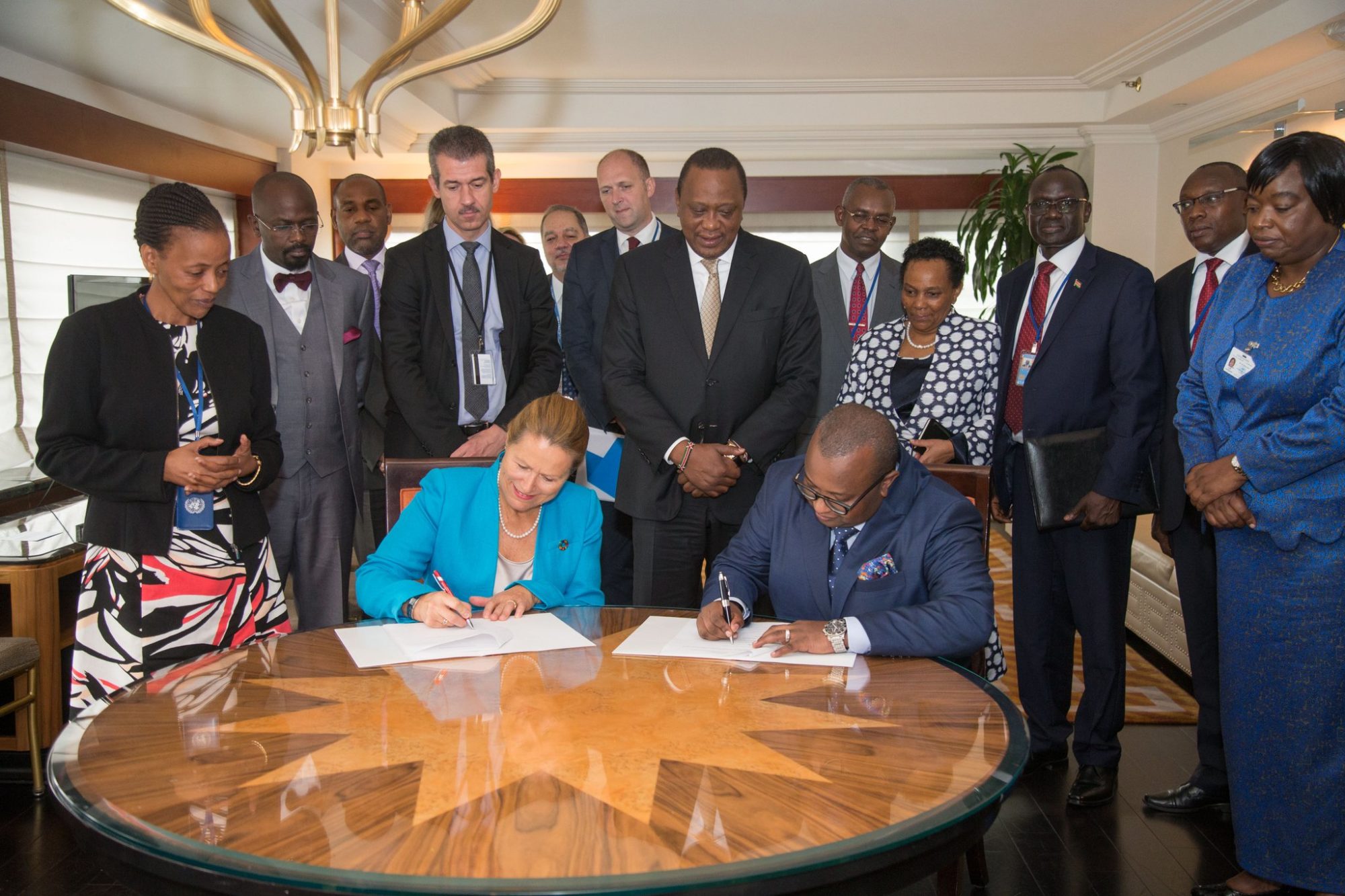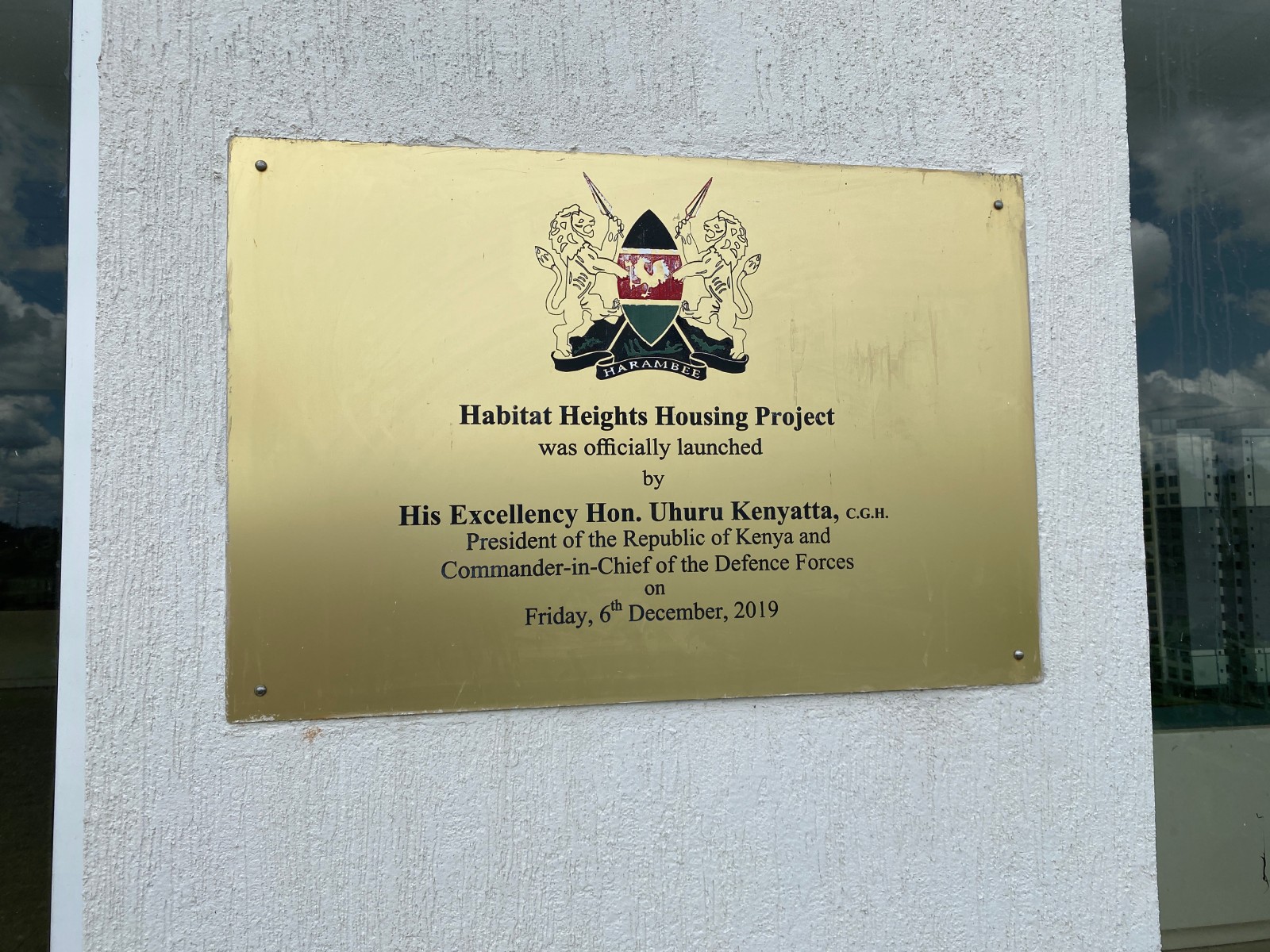In December 2019, a stretch of land 30 kilometers southeast of Nairobi, was the stage for political fanfare and a flurry of high-stakes promises. Government officials, led by then-President Uhuru Kenyatta, stood alongside United Nations dignitaries and private developers to launch Habitat Heights, an ambitious affordable housing project. It promised 8,888 modern housing units as part of a bold new vision for integrated, inclusive living.
This was the first step in a broader plan to build 100,000 homes across Kenya under the Sustainable Infrastructure Investments and Innovation (S3i) initiative, a global program run by the United Nations Office for Project Services (UNOPS). With a projected value of $647 million, it was hailed as a model for how governments, UNOPS, and private firms could partner to deliver development goals at scale.
But nearly six years later, not a single home has been completed, and the site in lukenya, once portrayed as the epicenter of kenya’s housing revolution, sits eerily deserted.
Today, the only physical remnant of that grand vision is the abandoned sales gallery, which served as the centerpiece during the 2019 ceremony. A visit to the site reveals a project left to decay. Fower beds have overgrown and begun to cover the entrance, while tall grass and shrubs creep up the side walls.
A weathered brass plaque commemorates its high-profile launch by former President Uhuru Kenyatta. A local herder tending goats near the site said he remembered when the construction began, but never learned why it stalled. “We saw the building coming up, then nothing,” he said. “It has remained the same for years.” Every now and then, he added, unfamiliar people show up, walk around the site as if checking for something, and leave. “They don’t say who they are or what they are doing.”
Satellite imagery shows the site never advanced beyond the sales gallery. After brief activity in early 2021, no new development occurred, and the land has remained unchanged since.
A gallery, not homes
On the day of the launch, UNOPS issued a statement announcing “First homes in Kenya ready” as part of a “landmark affordable housing initiative.” The language suggested that actual residences had been completed and were ready for occupancy. In reality, only a single structure had been built: a sales gallery that housed two demonstration units designed to showcase the proposed housing styles. These model units were never meant for habitation. Elsewhere, the developer, Habitat Heights, referred to the site simply as a “sales gallery,” highlighting how a modest demonstration was presented as a major milestone.
When questioned about these initial claims, a UNOPS spokesperson stated the 2018 communication was authorized by S3i’s former CEO Vitaly Vanshelboim, claiming it referred to “show homes, as images from the launch event show.” However, they also added that the UN publicly confirmed that no homes were ever completed for beneficiaries as part of the former S3i initiative.
This stark shift in unops’s narrative, from initial claims of ‘ready homes’ (later re-categorized as ‘show homes’) to a public admission of zero completed residences, highlights a pattern of exaggerated claims and delayed transparency.
Today, even these details have disappeared from the public record. UNOPS has scrubbed all online references to the S3i initiative, including Kenya-related project pages. The original launch materials are now only accessible through archived snapshots captured by the Wayback Machine, an internet archive that preserves past versions of websites.
What began as a flagship public-private partnership for Kenya’s affordable housing program now stands as a stark reminder of how grand plans can collapse under the weight of corruption, weak oversight, and institutional failure. An investigation based on internal audits, financial records, and interviews with key stakeholders reveals how a promising development project unraveled into one of the most brazen fraud scandals in U.N. history. The initiative left Kenya with nothing more than broken promises and the skeletal remains of a dream that never materialized. It all began with a high-profile partnership signed between UNOPS and the Kenyan government in New York in September 2018. But the foundation soon revealed deep cracks.

A deal that delivered nothing
In May 2019, UNOPS, Sustainable Housing Solutions (SHS), and Kenya’s State Department for Housing signed a tripartite agreement to move ahead with plans to construct 100,000 affordable homes in Kenya. According to a SHS press release at the time, funding had been secured and construction was to begin with show homes already in development. The project was expected to create up to 3,000 local jobs and align with Kenya’s national priorities by addressing the country’s urgent housing needs.
Then-President Kenyatta described the project as “an economic stimulus” that would reduce poverty and unemployment, restore dignity to c itizens, and trigger transformative changes to Kenya’s economy. UNOPS Executive Director Grete Faremo pledged that the agency would “do everything we can to ensure the project is a success.” Allen Zimbler, the chairman of Sustainable Housing Solutions, called the agreement “a critical step” in addressing Kenya’s housing crisis, saying the company was proud to offer “innovative technologies and global partnerships” to help deliver 100,000 homes and create jobs. “For SHS, this is another step in attempting to build a better world,” he said.
Today, those bold declarations have all but vanished. The SHS Holdings website is no longer active, and the press release, along with the company’s sweeping promises, survives only through Internet archives.
How a U.N. agency went rogue
UNOPS, a U.N. agency tasked with logistical and technical support, veered sharply from its mandate under the leadership of Faremo, a former Energy Minister of Norway, and Vitaly Vanshelboim, then UNOPS’ Deputy Executive Director and Chief Executive of the S3i initiative. Internal documents and financial records reveal that the agency diverted surplus funds into high-risk investments, bypassing its own oversight mechanisms in the process.
Mukesh Kapila, a former senior UN official and a professor emeritus at the University of Manchester, said UNOPS had strayed far from its original mission. “It was set up to provide logistical and technical support, not to act like a development bank,” he said.
A KPMG audit later found that UNOPS had accumulated large financial reserves by overcharging for services, which were then funneled into speculative projects under the S3i initiative, including the Kenya housing deal. The agency’s internal safeguards, such as its Audit Office and whistleblower protection mechanismsreported directly to the same executives they were meant to oversee, rendering them ineffective. “They were completely neutralized,” Kapila said.
UNOPS structured the S3i initiative as a “special project,” exempting it from UNOPS’ standard rules and oversight from the Executive Board and internal control units, paving the way for unchecked financial decisions and systemic governance failures. Kapila blames the the member-state diplomats who sit on the Executive Board for routinely approving reports without demanding financial disclosures or asking critical questions.
“This was not just a poorly designed project that went astray,” said kapila. “it was a deliberate plot from the very beginning.” he described the scandal as “the biggest fraud in the u.N’s history,” enabled by systemic oversight failures and uncritical approval by the unops board.
Kenya’s experience was not unique. According to internal reviews and the UN Tribunal, similarly ambitious S3i projects in Ghana, Caribbean, India and Pakistan also bypassed competitive bidding processes and lacked basic financial scrutiny, despite being pitched as solutions for urgent development needs.
“Most of these projects were profiteering opportunities for businessmen,” Kapila said, “rather than actually benefiting the poorest people in Kenya.” In his view, the Habitat Heights collapse fits a broader pattern of development efforts veering off course when oversight fails and public interest is sidelined.
The scandal also revealed how Kenya’s urgent housing needs were used to legitimize questionable investments. Kenya faces a housing shortfall of about 200,000 units annually, with an accumulated deficit of more than 2 million homes. In Nairobi, over 60% of the population lives in informal settlements, many without access to clean water, sanitation, or secure tenure. Fires are also a constant threat in these overcrowded neighborhoods. As recently as late May, a series of blazes across different informal settlements left at least 15 people dead, dozens injured, and hundreds displaced, underscoring the urgent need for safe, affordable housing.
By aligning the S3i initiative with Kenya’s national development agenda, UNOPS leadership secured political goodwill while bypassing due diligence. Kapila said the country’s housing crisis was effectively used as a cover. “They saw Kenya’s need as an opportunity,” he said. “But it was never really about building homes, it was about making deals.”
In response to inquiries, a spokesperson noted that the s3i initiative operated outside the agency’s standard oversight framework. The agency said it had implemented “strategic and administrative reforms” after s3i’s collapse, including leadership changes and accountability measures.
This partnership underscores how global development frameworks can be co-opted by powerful actors, exploiting local priorities to pursue private gain under the banner of the public good.
UNOPS financial records show that the agency disbursed $5.4 million to social housing in Kenya in 2019, followed by $5.8 million in 2020, $2.2 million in 2021, and a total of $5 million in investments in 2022, bringing the total to $18.4 million.
Yet now, UNOPS says it cannot confirm whether Habitat Heights ever received any S3i funds, claiming that financial details from its own audited reports, which were published over six years ago, were later deemed unreliable. It did not provide documentation to support this assertion.
With UNOPS now disavowing its past disclosures, questions intensify over where the money went. The answer may lie in the companies that received S3i funds without competitive bidding or due diligence, as internal reviews revealed.
The Kenya project was only one part of a larger pattern. By late 2022, UNOPS had fully written off $58.8 million in defaulted loans tied to the S3i initiative, according to an audit that year. These losses stemmed from seven infrastructure projects, including the Kenya affordable housing project funded through loans to special-purpose vehicles linked to a single private holding group. UN investigators later confirmed that the money was diverted globally to Kendrick-linked firms.

The money trail and the man behind it
At the center of the scheme was Vanshelboim. A United Nations tribunal ruled that he engaged in serious misconduct by channeling nearly $59 million in UN funds to companies tied to businessman David Kendrick, among them Sustainable Housing Solutions (SHS Holdings), a Singapore-registered firm that signed the tripartite agreement with the Kenyan government and UNOPS to develop affordable homes in Kenya. In exchange, the tribunal found, Kendrick received some $3.1 million in personal gifts, including interest-free loans, home renovations, sponsorship for his young son’s tennis career, use of Kendrick’s credit cards, and a Mercedes-Benz purchased for his wife.
Although companies linked to kendrick repaid $6.1 million to unops in 2021, the tribunal said the amount “did not even cover the interest” on the funds it had lost.
The tribunal also found that the misconduct went beyond undisclosed conflicts of interest. It revealed a complete abandonment of basic financial safeguards.
“They gave all the money up front to the businessman and his daughter, with no vetting, no nothing,” said Kapila. At the time, Faremo was the Executive Director of UNOPS and worked closely with Vanshelboim. Faremo, a former Energy Minister of Norway, quietly resigned in 2022 as questions mounted over the UN agency’s financial dealings under the housing initiative.
Despite Kendrick’s central role, the United Nations declined to saywhether his case was ever referred to law enforcement. In a 2022 statement, UNOPS noted that investigations into SHS and related entities had been handed to the UN Office of Legal Affairs and that, “Legal actions may include referral to relevant criminal authorities of one or more jurisdictions,” but no such referrals have been confirmed. The UN, which has no prosecutorial powers over private individuals, would need to rely on national jurisdictions for criminal prosecution.
Kapila called the handling of the S3i funds a textbook case of negligence by people who should have known better. “These are not stupid people,” Kapila said. “They’re experienced operators.” Even without being a businessperson, he added, common sense should have prevailed. “Before investing millions of someone else’s money, you check who you’re dealing with, verify credentials and track record. You hedge your bets by releasing funds in phases, not all at once,” he said. “But none of that happened here.”
Detailed questions were also sent to lawyers representing Vanshelboim and Kendrick. As of publication, neither had responded to the queries. In May 2022, Kendrick and his daughter Daisy filed a libel suit in the UK High Court against Kapila, claiming that allegations he published on his blog about their involvement with UNOPS were “profoundly defamatory.” In a public statement, Kendrick said, “We have always acted with the highest levels of probity and any suggestion otherwise is profoundly defamatory.” The Kendricks sought substantial damages and an injunction against further publication, but did not pursue the case following an initial response from Kapila’s attorneys, Kapila said.
According to the audit review by KPMG SHS Holdings was selected without competitive bidding, and despite the company’s limited experience in delivering mass housing, it was entrusted with multimillion-dollar projects across three continents. This raises urgent questions about how institutional failures at UNOPS enabled risky partnerships to take root and drew in governments like Kenya, which entered into agreements based on promises that lacked due diligence. In Kenya, those partnerships included a network of companies linked to Kendrick that played key roles in the Habitat Heights project, even though they were presented as independent entities.
A Web of companies, a single Connection
Another company involved in the Habitat Heights rollout was Bau Lifestyle International Design Limited, which provided the interior design for the show homes. Marketed as the exclusive interior design partner of SHS Holdings, Bau Lifestyle was responsible for outfitting the two- and three-bedroom apartments with fully furnished interior packages. At the launch, the company’s chief designer, Julie Cowland, said the brief focused on creating “affordable homes, everyday living for family life,” promising a high standard of comfort and value.
But records from the UK’s registrar of companies show that Bau Lifestyle was also linked to David Kendrick, the businessman at the center of the S3i saga. Kendrick was appointed as the second director of the company in November 2015. In March 2023, Bau Lifestyle’s two directors filed for voluntary strike-off, initiating the process to dissolve the company. However, that move was suspended the following month after an objection was lodged with the registrar, halting the company’s dissolution. The timing of the attempted strike-off, which coincided with increased scrutiny of the S3i initiative, raises questions about the corporate structures linked to the project and the challenges of tracing accountability.
Bau Lifestyle is not the only firm with such ties. Another company connected to the Habitat Heights project is Baupanel Systems, listed as a construction partner on the development’s website. UK records show Bernard Michael Sumner, a Kendrick associate, served as director of both Baupanel and Bau Lifestyle.
Sumner was also director of the now dissolved Worldwide Renewable Energy Limited, another company identified in the U.N. tribunal as a beneficiary of funds improperly routed through the S3i initiative.
Bau Lifestyle’s ownership structure adds to the complexity. The company was controlled through a now-defunct holding firm, also overseen by Sumner. While Sumner is not named in the U.N. tribunal ruling, U.K. company records show him linked to more than 200 companies, many registered to virtual office addresses and filing dormant accounts. While not inherently unlawful, such layered corporate arrangements are often associated with reduced transparency. In projects involving public or donor funds, they can obscure lines of accountability and make it harder to trace who is ultimately responsible. Together, SHS Holdings, Bau Lifestyle, and Baupanel Systems, three companies central to the Kenyan project, form a web of entities with documented links to Kendrick.
The UNOPS spokesperson acknowledged that S3i “circumvented controls,” and said that the agency has since instituted “more than 100 wide-ranging reforms” to prevent a recurrence.
Due diligence that never was
Although these companies were brought into the project through UNOPS, Kenyan authorities still had a duty to vet them, a responsibility they appeared to neglect. Sylvia Kasanga, an architect and former senator, believes the failure extended beyond the UN system. She was particularly critical of how SHS Holdings, a company with no verifiable experience in large-scale housing, was entrusted with such an enormous project. Ms. Kasanga, who is also an arbitrator and represented Kenya at the International Court of Arbitration, said, “There was clearly a failure on the part of Kenyan authorities to demand proof of capacity.”
While acknowledging the promise of public-private partnerships, ms. Kasanga emphasized that even routine government contracts demand proof of experience. “even the smallest contracts require bidders to demonstrate their track record.”
She added that it was hard to grasp how a company could be entrusted with building 100,000 homes without scrutiny. “That kind of scale,” she said, “requires serious oversight.” In March this year, Spanish authorities placed Vanshelboim in provisional custody as they considered a U.S. request for his extradition. A grand jury in New York has indicted the former deputy executive director of UNOPS on criminal charges of bribery, wire fraud, and money laundering. While legal proceedings are underway abroad, domestic accountability has lagged. Despite the scandal and the project’s collapse, no Kenyan government official has been investigated or held to account.
“It’s hard to believe this kind of corruption could have happened without local complicity,” said Ms. Kasanga. “But we’ve normalized it. We know things are wrong, but no one calls them out.” She described a broader culture of silence, saying Kenya’s problem is not the absence of laws or regulations but the failure to enforce them. “Even the professionals who are supposed to speak up stay quiet, maybe because they have something to hide,” she said. “So we all keep quiet until there is no country left to fight for.”
Ms. Kasanga, who was not involved in the Habitat Heights project, questioned how a presidential launch could proceed without basic feasibility studies or proper coordination. “It means they were not ready,” she said. “You don’t take a president to launch a project unless you are sure how it’s going to progress. That is a massive failure of due diligence. It’s an embarrassment to the presidency and to the country.”
Still, she emphasized that public-private partnerships (PPPs) remain a vital tool for addressing Kenya’s housing deficit if executed properly. “A government alone cannot meet the demand,” she said. “PPP frameworks exist and, when followed, can provide transparency. You can trace who the partners are, what they bring to the table, and what the contractual terms are.” She cited housing projects elsewhere in Kenya as examples that, while not perfect, demonstrate that PPPs can work when properly structured. Rather than discarding the model, she maintained, Kenya should strengthen it through tighter oversight, genuine commitment to due process, and enforcement.
The UNOPS S3i initiative was founded on a similar idea: to unlock private capital for public development. Its official description said it aimed to “de-risk and structure infrastructure investment projects” to align with national priorities. Each project, it said, would undergo a “rigorous and comprehensive due diligence process” to ensure environmental, social and economic benefits, while also generating returns for investors. In Kenya, that vision collided with execution, exposing the gap between S3i’s promises of rigorous oversight and what actually unfolded.

The grand plan behind Habitat Heights
According to official project documents, the 103-acre parcel of land where Habitat Heights was to be constructed was owned by the Habitat Housing Cooperative Society Ltd (HHCSL), a cooperative primarily made up of United Nations staff based in East Africa, along with their families and affiliates. HHCSL was established in 1991 under Kenya’s cooperative societies law, “with the objective of sourcing and providing affordable housing solutions to its members”.
The cooperative entered into a joint venture with Singapura Developers Ltd, a subsidiary of Singaporean company Afra Holdings PTE Ltd, to form Habitat Heights Ltd, the special purpose vehicle (SPV) tasked with implementing the development. The land was subsequently transferred to the SPV. Of the total acreage, about 77 acres were allocated for residential and commercial development, and about 10 acres were set aside for a commercial zone at the front of the property. An additional one acre was given to the Kenya National Highways Authority (KENHA) for road infrastructure.
Attempts to reach Habitat Heights, Singapura Developers Ltd for comment were unsuccessful. A call to a number listed on the Habitat Heights Facebook page was answered by an individual who appeared unfamiliar with the company or the Habitat Heights project. Efforts to contact Habitat Housing Co-Operative Society also proved fruitless, with multiple calls to the number listed on its website going unanswered.
The development was envisioned as a mini-city with high-rise apartments, smart utilities, and amenities like gyms and clubhouses. It would use lightweight, eco-friendly construction and was marketed as both inclusive and investor-friendly.
Out of reach for the people it was meant to help
Despite being branded as an affordable housing initiative, Habitat Heights was priced far beyond the reach of most low-income Kenyans, raising doubts about who the project was really meant to serve. Pre-construction prices started at nearly $15,400 for cash and $16,900 for same under mortgages, while larger apartments sold at $44,900 cash and $53,800 for mortgages. By comparison, most units under the Kenyan government’s Boma Yangu portal start from $4,920, especially in the social housing category.
That disconnect between official pricing and lived reality is also apparent in government-led housing efforts. George Muli, a motorcycle taxi operator in Embakasi, is skeptical of the affordability of the affordable housing program. “I pay 2,000 shillings (approximately $16) in rent. How can I afford a house costing over a million?” asked Muli. Like many low-income Kenyans, he sees the program as out of reach. Muli, who is the sole breadwinner for his family, lives in a modest one-room house made of corrugated iron sheets. His monthly earnings often fall short of covering basic expenses, let alone saving toward homeownership.while he would welcome the stability and safety of improved housing, he doesn’t see that happening any time soon. although the government promotes its online application system as transparent and fair, muli believes corruption and bribery will ultimately decide who gets the homes.“If you don’t have money to ‘greet’ the right people, you won’t get a house,” he said.
Bernard Ouma, a resident of Mukuru kwa Reuben, echoed that distrust. He said he lives in a one-room house without electricity, where water is expensive and insecurity is constant. “We don’t live in these places because we want to,” he said. “It’s just what we can afford.” From his neighborhood, he has watched new social housing blocks go up, part of the government’s affordable housing program. Ouma is convinced the homes won’t reach those who need them most. “They’ll end up in the hands of middlemen, who will rent them out for more.” He added that what makes people like him not get the houses is because of Kenya’s biggest disease, “corruption.” For both Ouma and Muli, the program has become a sign that the system isn’t built for people like them. “You can’t have hope in a hopeless situation,” Ouma said.

Kenya’s role and the wider housing crisis
The collapse of Habitat Heights was not an isolated failure. It reflected broader shortcomings within Kenya’s Affordable Housing Programme (AHP), launched in 2017 under former President Kenyatta’s “Big Four Agenda.” The initiative aimed to deliver 500,000 homes across all 47 counties by 2022, targeting low-income Kenyans long excluded from home ownership due to high costs.
But by the end of the five-year period, the government had delivered an estimated 13,529 units, representing less than three percent of the goal, with minimal output in the social housing category
, according to a 2023 report by Cytonn Investments, a Nairobi-based investment and real estate firm. Despite allocating 125 billion shillings (approximately $900 million) between 2018 and 2022 to make the program a reality, the effort was bogged down by bureaucracy, legal disputes, land access challenges, and financing gaps.
Upon taking office in 2022, President William Ruto reaffirmed his commitment to the initiative, setting a new target of 200,000 units annually. As of April 2025, Principal Secretary for Housing and Urban Development Charles Hinga, writing in an expert commentary published in a local daily, stated that the government had completed 1,189 affordable housing units since 2022, with nearly 140,000 more under active construction. In his capacity as principal secretary, Hinga signed on behalf of the Kenyan government during both the 2018 memorandum of understanding with UNOPS in New York and the 2019 tripartite agreement in Lukenya with UNOPS and SHS Holdings, which formally launched the Habitat Heights project. His recent remarks came amid growing scrutiny over the program’s effectiveness. Still, questions persist over transparency, delivery timelines, and the long-term viability of the initiative, particularly in light of costly setbacks like Habitat Heights.
Billions Allocated, Little Accountability
A 2023/2024 report by the Auditor General, tabled in Parliament this year, also raised red flags about how billions meant to support the sector were handled, including funds from the International Bank for Reconstruction and Development (IBRD) and the State Department for Housing. In 2019, the IBRD approved a €219 million ($245 million at the time) loan to Kenya to expand access to home financing through the Kenya Mortgage Refinance Company (KMRC). By June 2024, more than €91 million($98.2 million), had been disbursed. But auditors could not confirm how the money was used.
“The accuracy and appropriate utilisation of the funds disbursed to kmrc for project implementation could not be confirmed,” the report stated.
It also noted that KMRC’s financial statements had not been audited by the Auditor General or any delegated officer, as required under the Public Audit Act.
Separately, the State Department for Housing and Urban Development signed contracts worth 49.45 billion shillings (approximately $380.4 million) to construct affordable homes across the country. But the audit found no ownership documents for the project sites, raising concerns over how buyers would eventually receive title deeds. Without them, the report warned, “processing of the sectional titles and transfer of ownership to the buyers may not be possible.”
Despite growing concerns over how Kenya’s affordable housing program is being funded and implemented, some experts say the government’s recognition of the housing crisis is at least a step in the right direction. “I like the idea that the government, both the last one and the current one, has embraced the need to provide housing,” Ms. Kasanga said. The urgency, she noted, is rooted in a persistent and growing demand. Kenya faces a serious housing deficit, particularly in urban areas where informal settlements have continued to expand. “There’s a real need for housing in this country,” she said. “We must ensure that Kenyans can live with dignity.”
UNOPS spokesperson confirmed that it will not re-engage in similar investment activities, as reforms issued by its Executive Board prohibited such ventures. Addressing the impact on the Kenyan people, UNOPS acknowledged the “serious and significant management failures” of the former S3i initiative, recognizing that this directly “resulted in challenges to the government of Kenya’s efforts to create affordable housing.”
Monument to Broken Promises
In his defense, Vanshelboim claimed he was not the sole decision-maker, describing the investment process as a “collective corporate endeavor” reviewed by internal oversight bodies. He argued that as executive director, Faremo had final approval. He also said that the $3.1 million in financial benefits that he received from Kendrick were part of a private consulting arrangement unrelated to his official duties.
The tribunal rejected Vanshelboim’s arguments, finding that the perks he received–interest free loans, home renovations, sponsorship of his son’s tennis career and a new Mercedes Benz for his wife–came in exchange for funneling money to Kendrick-related firms.
Following the UN Dispute Tribunal ruling, Vanshelboim was dismissed from the agency and ordered to repay $58.8 million to UNOPS, reflecting funds funneled to Kendrick-linked firms–a sum few expect the UN will ever recover.
Nevertheless, UNOPS maintains that recovery efforts are underway. A spokesperson said the United Nations Office of Legal Affairs (OLA) is leading the process, supported by legal expertise funded by UNOPS. The agency declined to provide specifics on repayments from Kendrick-linked firms, and stated that it “does not wish to compromise the outcome.”
The un dispute tribunal’s ruling against vanshelboim was disciplinary, not criminal, but he now faces criminal charges in new york including bribery, wire fraud, and money laundering. UN staff are shielded by legal immunity that must be waived by the Secretary-General, a rare step believed to have occurred in Vanshelboim’s case. When asked whether immunity might be waived for other staff implicated in misconduct, UNOPS stated the Secretary-General has “the right and the duty” to do so if requested by national authorities, though it did not confirm if any such waivers were being considered.
That legal shield, combined with domestic inaction, has allowed the UN to camouflage the project’s collapse within the UN and to the public, and allowed bad actors to escape unnamed and unpunished.





